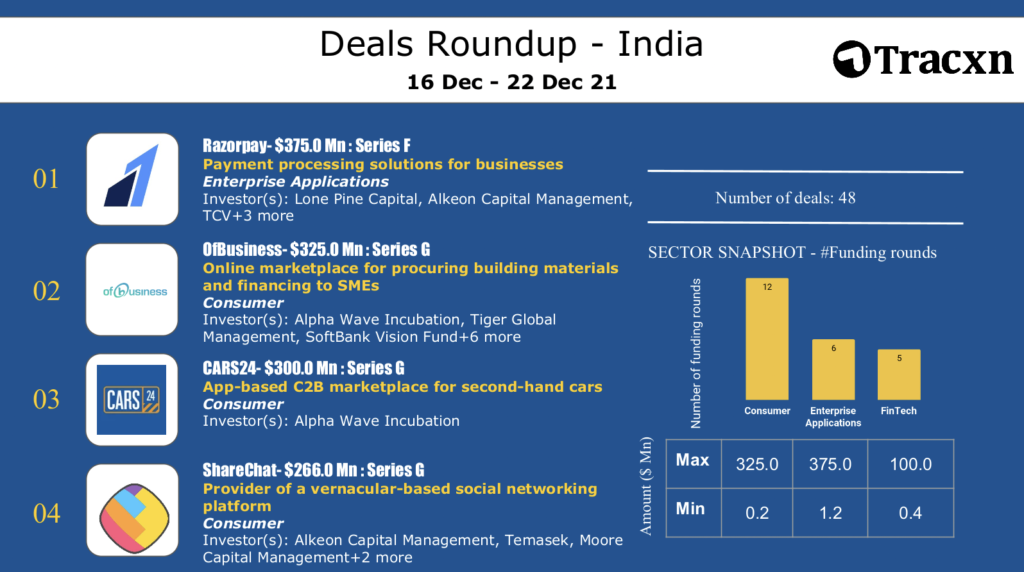Subscribe to our newsletter to read this first thing on Friday morning. This is the preview of what you will receive in your inbox.
This week was primarily about looking back at the past year and analyzing the changes that happened in the Indian startup ecosystem. 2021 has turned out to be a milestone year for the local startup community that witnessed it all—record capital inflows, an unprecedented number of startups entering the unicorn club, and startups going public.
For context, local startups raised almost USD 36 billion in 2021—a whopping 200% more than last year. 41 startups turned into billion-dollar companies after landing fat checks from marquee investors like Tiger Global and SoftBank. Meanwhile, a slew of high-profile tech startups went public successfully proving the public market appetite for new-age firms, pleasantly surprising local startup and VC community.
Amid all this, local consumer tech startups began eyeing overseas markets and started building products and services for the global audience. As the Indian startup ecosystem matures, industry experts expect massive capital inflows to continue and the exit market to remain rosy.
In the last newsletter of 2021, KrASIA took a look at the past year from different lenses.
The Big Read
Unexpected things that defined Indian startup ecosystem in 2021 | KrASIA Year in Review
For the Indian startup ecosystem, 2021 couldn’t have been more different than 2020—the year of the COVID-19 outbreak that changed the world forever.
Last year brought the local startup community to its knees, forcing them to focus on driving sustainable growth with reduced cash and better unit economics rather than chasing growth over profitability, a practice that had defined the startup industry for the past decade. Startup entrepreneurs leveled up as they navigated through the slowdown brought upon by the public health pandemic. Going back to basics, they learned to do more with less and figured out ways to build failsafe businesses.
By the end of 2020, two things happened that set the stage for this year—rapid mass digitization in the South Asian nation and the VC funding rebound.
Despite the overhang of the healthcare crisis, 2021 turned out to be a milestone year for the Indian startup ecosystem. As consumer internet startups grew massively on the back of hundreds of millions of Indians devouring content and services online and transacting more than ever before, they raised an exorbitant amount of capital and scaled even faster.
This led to VCs writing bigger checks at higher valuations. Overall, this year investors pumped nearly USD 36 billion into startups—200% more than 2020, which in turn created 41 unicorns. While investor sentiment was at an all-time high, a slew of startups took the call and decided to go public in a bullish market, which made global investors even more excited.
As 2021 draws to a close, KrASIA looked beyond the obvious at unexpected things that have defined the local startup ecosystem this year.
The Weekly Buzz
1. KrASIA looked at new emerging sectors that shined in India in 2021. These include crypto, quick commerce, and D2C—all of which saw rapidly increasing consumer interest and a massive amount of capital influx this year. While crypto startups raised USD 485 million from private equity and venture funds this year, D2C brands and companies saw investors pouring USD 1.7 billion in the first three quarters of 2021. Furthermore, the quick commerce space has become the new battleground for e-grocers, e-retailers, and hyperlocal players.
2. SoftBank-backed Snapdeal aims to raise USD 165 million from IPO, eyes international expansion. In a draft prospectus filed earlier this week, the e-retailer said its offer will comprise a fresh issue of equity shares worth up to INR 12.5 billion (USD 165 million) and existing investors selling up to 30.76 million shares under offer for sale. While the company did not disclose the total size of the IPO, it is reported to be a USD 250 million public offer. Snapdeal plans to use INR 9 billion (USD 119 million) from the IPO proceeds for organic growth initiatives over the next five financial years.
3. Indian millennials are buying now and paying later during an uncertain economy. They are increasingly using buy now, pay later (BNPL) services to shell out for online purchases, whether they are for food or travel tickets. A report by market researcher RedSeer predicts the BNPL industry in the country will increase more than tenfold over the next five years, growing to become a USD 50 billion market by 2026 from USD 3.5 billion currently. Users of BNPL services are estimated to rise to 100 million, compared to today’s 10–15 million.
Top Deals This Week

